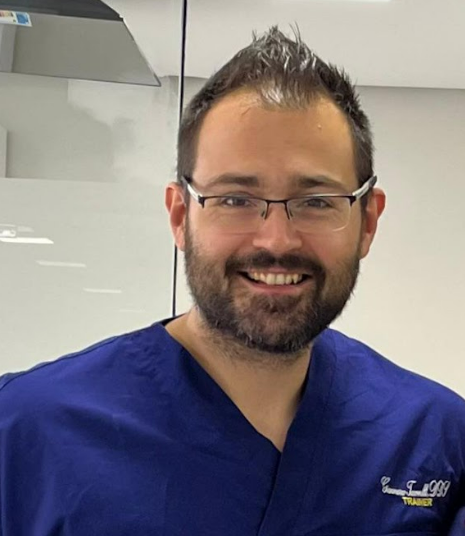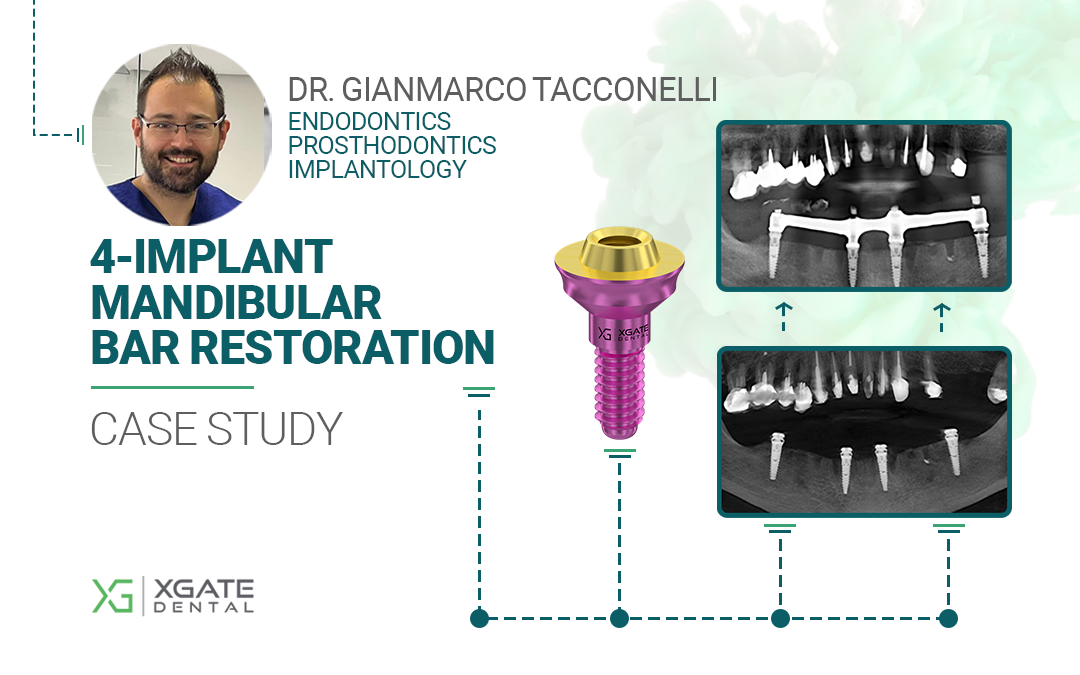
This clinical case was provided by Dr. Gianmarco Tacconelli from Pescara, Italy.
With over 11 years of clinical experience, Dr. Tacconelli specializes in implantology and maxillary rehabilitation, with advanced expertise in zygomatic and pterygoid implants, as well as bone grafting procedures in cases of severe atrophy.
Main areas of expertise: Endodontics, Prosthetics, Implantology.
Patient
A 72-year-old, non-smoking male presented to the clinic with complex dental issues in both the maxilla and mandible, as seen in the initial photographs and CBCT scan.


The remaining teeth were deemed non-restorable and required extraction.
Diagnosis and Treatment Planning
The 3D CBCT scan revealed previous endodontic treatments and chronic inflammatory periapical lesions associated with the remaining teeth.

The analysis of the residual bone volume in the posterior regions showed a sufficient amount of bone in both the bucco-lingual and apico-coronal dimensions to allow for dental implant placement.
In the anterior region (interforaminal area), the alveolar ridge was too narrow for implant insertion without bone modification. However, the basal bone provided adequate volume to anchor and stabilize the implants.
After careful analysis and risk assessment, a treatment plan based on the Full-Arch protocol was formulated:
- Extraction of the remaining teeth.
Osteoplasty to reduce the alveolar crest would be performed prior to implant placement.
Selected implants XGATE Dental X3 Internal Hex:
- Anterior region: Ø3.3 × 13 mm
- Posterior regions: Ø3.75 × 13 mm

As the Full-arch protocol involves immediate loading, the surgical site preparation and implant placement technique needed to achieve a minimum insertion torque of 35 Ncm.
Treatment Summary
The first stage of the operation included:
- Extraction of the remaining teeth.
- Debridement of the extraction sockets.
- Alveolar crest reduction.
The photo below shows the surgical site after the osteoplasty. Following this, the osteotomies were prepared, and the implants were placed.

The implants were placed successfully, and four straight V-type multi-unit abutments (XGate Dental) with a 1 mm collar height were immediately seated. The implants were placed with an insertion torque of 45-50 Ncm, indicating excellent primary stability while remaining within safe clinical limits.

1mm Straight MUA V-type 5201.1001


The prosthetic plan involved a screw-retained prosthesis supported by a cast cobalt-chrome bar (Toronto Bridge style) to ensure optimal load distribution on the implants.
During the impression phase, a difficulty arose. The clinician initially attempted to take the impression using the temporary abutments, which can sometimes also serve as impression transfers. However, these abutments were too short to remain adhered to the impression material, resulting in an unstable and inaccurate impression.
Consequently, it was decided to fabricate a custom resin tray to capture a precise impression, splinting the abutments together to ensure maximum accuracy during the impression procedure. This technique allowed for an accurate impression for the fabrication of the prosthesis.











Occlusion control passed successfully.

During this healing period, the underlying soft tissues remodeled as expected. To ensure a precise and comfortable fit to the new tissue contours, the prosthesis required a reline.
This was accomplished using an indirect relining technique:
- An accurate impression of the soft tissue surface was taken using a low-viscosity (light-body) impression material.
- In the laboratory, the internal surface of the prosthesis was adjusted based on this new impression.
- A few hours later, the patient received the relined prosthesis, which now fit perfectly to the healed tissues.



Before proceeding with the maxillary rehabilitation, the clinician verified the health and stability of the soft tissues surrounding the mandibular implants.

XGate Products Featured in Case
The treatment plan required four XGate Dental X3 Internal Hex implants (Ø3.3 mm and Ø3.75 mm), four straight V-type multi-unit abutments with 1 mm collar height, and prosthetic components including temporary sleeves, impression transfers, and castable sleeves for the milled titanium bar fabrication.
Download Resources
Get the complete case study and explore our product catalog
Case Study • PDF • 1.3 MB
📥 Download Case StudyProduct Catalog • Online
🔍 View Product CatalogWe hope you found this clinical case interesting. If you have any questions about the characteristics and delivery of XGate Dental products, please contact us in any convenient way.
E-mail: [email protected]
350 W Passaic
St Rochelle Park, NJ 07662
United States
XGate Dental Group GmbH
Falkensteiner Straße 77, 60322
Frankfurt am Main
Germany
Disclaimer: Any medical or scientific information provided in connection with the content presented here makes no claim to completeness and the topicality, accuracy and balance of such information provided is not guaranteed. The information provided by XGATE Dental Group GmbH does not constitute medical advice or recommendation and is in no way a substitute for professional advice from a physician, dentist or other healthcare professional and must not be used as a basis for diagnosis or for selecting, starting, changing or stopping medical treatment.
Physicians, dentists and other healthcare professionals are solely responsible for the individual medical assessment of each case and for their medical decisions, selection and application of diagnostic methods, medical protocols, treatments and products.
XGATE Dental Group GmbH does not accept any liability for any inconvenience or damage resulting from the use of the content and information presented here. Products or treatments shown may not be available in all countries and different information may apply in different countries. For country-specific information please refer to our customer service or a distributor or partner of XGATE Dental Group GmbH in your region.
